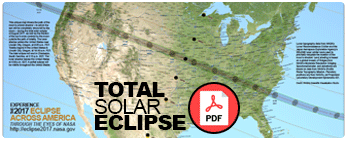Math Challenges
One of the reasons that ancient peoples could not predict total solar eclipses was because they did not appreciate the mathematics involved in forecasting. Also, many of the parameters needed to accurately predict eclipses had not been astronomically measured until the first century CE. If you are taking a trip to visit Grandma in another town and want to predict at what time you will arrive, it really helps to know how, many road miles you will be traveling and how fast you will go!
Here are a selection of math challenges that will take you through some of the basic mathematics related to the August 21, 2017 eclipse. The mathematics level span all grades and abilities from elementary proportions and algebra all the way up to trigonometry and, yes, the calculus!
Challenge 1 – Working with Geographic Coordinates
How to use longitude and latitude measure.
Read MoreChallenge 2 – X Marks the Spot
Find where two eclipse tracks cross by graphing them
Read MoreChallenge 3 – X Marks the Spot
Find where two eclipse tracks cross by solving two linear equations for their intersection point.
Read MoreChallenge 4 – X- Marks the Spot with Quadratic Equations
Use the Quadratic Formula to find the intersections points for two eclipse tracks.
Read MoreChallenge 5 – Estimating the Speed of the Lunar Shadow
From the distances between observers along the path of the 2017 eclipse, and the eclipse times, estimate the speed of the moon’s shadow.
Read MoreChallenge 6 – As the Crow Flies on a Spherical Planet
Use a trigonometric formula involving sines and cosines to calculate the distance in kilometers between any two points on Earth from their longitudes and latitudes.
Read MoreChallenge 7 – Exploring the Lunar Shadow Cone
From basic angular measure and proportions, estimate the length of the lunar shadow cone during the August 21, 2017 eclipse.
Read MoreChallenge 8 – Exploring Angular Diameter
Use angular measure and proportions to determine the apparent size of the sun and moon.
Read MoreChallenge 9 – Lunar Shadow Size on Earth’s Surface
Estimate the diameter of the lunar shadow on Earth’s surface using geometry and proportions.
Read MoreChallenge 10 – Shadow Speed and Earth’s Rotation
Use the cosine law for Earth’s rotation speed to estimate the ground speed of the lunar shadow at different latitudes.
Read MoreChallenge 11 – Modeling Shadow Speed, Diameter and Duration along the Path of Totality
Use an algebraic model of the moon’s shadow speed and diameter to estimate how long totality will last.
Read MoreChallenge 12 – Shadow Ground Speed
Use a physics-based model of the earth-moon system to determine the ground speed of the lunar shadow, and the distance to the moon from Earth.
Read MoreChallenge 13 – The Last Total Solar Eclipse on Earth
Use linear equations to predict how long we will continue to have total solar eclipses as the sun grows larger and the moons gets farther from Earth.
Read MoreChallenge 14 – Time on Mars
NASA scientists and engineers using rovers on Mars have to use the Martian time system based on a longer day. In this challenge, you will calculate when the Curiosity would be able to observe Earth during the August 21, 2017 total eclipse.
Read MoreChallenge 15 – Angular Size and Views of the Earth-Moon System
The photographed sizes of objects in space depends on how far you are from them. This leads to many fascinating pictures of huge moons and planets that are not usually in proportion to their actual sizes.
Read MoreAnswer Key for Challenge
Answer to Challenge Problems
Read More




